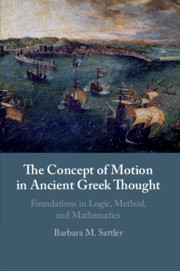Book contents
- The Concept of Motion in Ancient Greek Thought
- The Concept of Motion in Ancient Greek Thought
- Copyright page
- Contents
- Acknowledgements
- Introduction
- 1 Conceptual Foundations
- 2 Parmenides’ Account of the Object of Philosophy
- 3 Zeno’s Paradoxes of Motion and Plurality
- 4 The Atomistic Foundation for an Account of Motion
- 5 The Possibility of Natural Philosophy According to Plato I: The Logical Basis
- 6 The Possibility of Natural Philosophy According to Plato II: Mathematical Advances and Ultimate Problems
- 7 Aristotle’s Notion of Continuity: The Structure Underlying Motion
- 8 Time and Space: The Implicit Measure of Motion in Aristotle’s Physics
- 9 Time as the Simple Measure of Motion
- Bibliography
- Index Locorum
- General Index
6 - The Possibility of Natural Philosophy According to Plato II: Mathematical Advances and Ultimate Problems
Published online by Cambridge University Press: 28 September 2020
- The Concept of Motion in Ancient Greek Thought
- The Concept of Motion in Ancient Greek Thought
- Copyright page
- Contents
- Acknowledgements
- Introduction
- 1 Conceptual Foundations
- 2 Parmenides’ Account of the Object of Philosophy
- 3 Zeno’s Paradoxes of Motion and Plurality
- 4 The Atomistic Foundation for an Account of Motion
- 5 The Possibility of Natural Philosophy According to Plato I: The Logical Basis
- 6 The Possibility of Natural Philosophy According to Plato II: Mathematical Advances and Ultimate Problems
- 7 Aristotle’s Notion of Continuity: The Structure Underlying Motion
- 8 Time and Space: The Implicit Measure of Motion in Aristotle’s Physics
- 9 Time as the Simple Measure of Motion
- Bibliography
- Index Locorum
- General Index
Summary
Chapter 6 examines Plato’s introduction of mathematical structures in order to explain the natural world. It contrasts his ‘mathematical approach’ to nature with that of the Pythagoreans, and shows how his use of mathematics enables Plato to make motion intelligible in itself to a certain degree. For this, the idea of measuring motion in temporal terms is crucial. However, Plato’s treatment of measurement in the Timaeus does not include measuring the distance covered by a motion. And Plato’s treatment of time and space (the receptacle) as entities of fundamentally different status, taking time to be intelligible in a way in which space is not, prevents him from connecting time and space in an account of speed. It is shown that Plato instead reduces speed to the time a motion takes. The chapter finishes by spelling out the problematic consequences of this reduction – that it only allows for restricted comparability of different motions and that in certain cases it can lead into inconsistencies.
- Type
- Chapter
- Information
- The Concept of Motion in Ancient Greek ThoughtFoundations in Logic, Method, and Mathematics, pp. 245 - 276Publisher: Cambridge University PressPrint publication year: 2020



